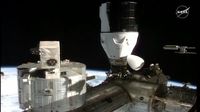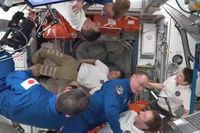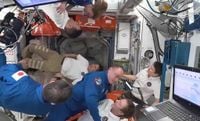On Saturday, August 2, 2025, SpaceX successfully delivered a fresh crew of four astronauts to the International Space Station (ISS), completing the journey in a swift 15 hours after launching from NASA's Kennedy Space Center in Florida. The international team—comprising NASA astronauts Zena Cardman and Mike Fincke, Japan Aerospace Exploration Agency (JAXA) astronaut Kimiya Yui, and Roscosmos cosmonaut Oleg Platonov—docked their Crew Dragon capsule Endeavour with the orbital laboratory just after 2:26 a.m. Eastern Daylight Time, approximately 264 miles above the South Pacific Ocean.
This mission, known as Crew-11, marks the 11th operational astronaut flight SpaceX has conducted to the ISS under NASA's Commercial Crew Program, a vital initiative designed to succeed the Space Shuttle era by partnering with private industry. The Endeavour capsule, SpaceX's most-flown Crew Dragon vehicle, has now completed six missions, including this latest one. The docking occurred exactly five years after the splashdown of SpaceX's first-ever crewed mission, Demo-2, which also utilized Endeavour.
Following the docking, the crew performed standard leak checks and pressurization procedures between the two spacecraft. The hatches between Endeavour and the ISS were expected to open around 4:45 a.m. EDT, followed by a welcome ceremony. Already aboard the station were seven astronauts: JAXA's Takuya Onishi, commander of Expedition 73; NASA astronauts Anne McClain, Nichole Ayers, and Jonny Kim; and Roscosmos cosmonauts Kirill Peskov, Sergey Ryzhikov, and Alexey Zubritsky.
Mike Fincke, Crew-11's pilot, warmly greeted the station upon docking with the words, "Hello space station, Crew 11 is here! And we are super excited to join Expedition 73. We will do our best to also be good stewards of our beautiful ISS during our stay." NASA astronaut Jonny Kim responded from inside the station, "Endeavour, welcome to the International Space Station. Zena, Mike, Kimi and Oleg, we have cold drinks, hot food and hugs waiting. See you soon." This exchange highlighted the camaraderie and human connection that persist even in the high-tech realm of spaceflight.
The Crew-11 astronauts will relieve four colleagues—Ayers, McClain, Onishi, and Peskov—who have been aboard the ISS since mid-March 2025, arriving on SpaceX's Crew-10 mission. The outgoing crew is scheduled to return to Earth as early as Wednesday, August 6. This seamless handover ensures the ISS continues its uninterrupted human presence in space, a streak ongoing for nearly 25 years since 2000.
Each Crew-11 astronaut brings a unique background and journey to this mission. For Zena Cardman and Oleg Platonov, this marks their first spaceflight, while Kimiya Yui embarks on his second, and Mike Fincke his fourth. Originally, Cardman, Fincke, and Yui had been slated for different missions, particularly involving Boeing’s Starliner spacecraft. However, persistent technical issues with Starliner—including thruster malfunctions—have grounded the vehicle until at least 2026. This led to a reshuffling of crew assignments, with Cardman and another astronaut being pulled from a 2024 SpaceX flight to make room for Boeing Starliner test pilots Butch Wilmore and Suni Williams. Wilmore and Williams’ mission, initially planned for one week, extended to over nine months due to Starliner’s delays.
Fincke and Yui had been training for upcoming Starliner flights but switched to SpaceX's Crew Dragon following the Starliner program’s setbacks. Meanwhile, Oleg Platonov was originally assigned to a Soyuz launch but was removed due to an undisclosed illness, which has since been resolved. Their eventual arrival at the ISS temporarily increases the station’s population to 11 astronauts.
Despite the 15-hour transit time being notably fast by U.S. standards, the Russian Soyuz spacecraft still holds the record for the quickest trip to the ISS, completing the journey in only three hours. Nevertheless, SpaceX’s rapid docking underscores the growing reliability and efficiency of commercial spaceflight, enhancing NASA’s ability to maintain continuous operations aboard the station.
During their six-month mission, the Crew-11 astronauts will undertake a variety of scientific and operational tasks. Notably, they will simulate lunar landing scenarios near the Moon’s South Pole as part of NASA's Artemis program. Using handheld controllers and multiple display screens, they will study how shifts in gravity affect astronauts' ability to pilot spacecraft, including future lunar landers. This research is critical for informing upcoming deep space exploration missions, including eventual journeys to Mars.
Among the unique cargo aboard Endeavour were Armenian pomegranate seeds, destined for experiments comparing their growth in microgravity to control batches on Earth. Such botanical studies help scientists understand how plants develop in space, which is vital for future long-duration missions requiring sustainable food sources.
Zena Cardman reflected on the mission's significance, saying, "This has been the absolute journey of a lifetime. We are so incredibly grateful to be here. Thank you so much for this warm welcome. It was such an unbelievably beautiful sight to see the space station come into our view for the first time, especially with these wonderful crewmates." Her words capture the awe and dedication that continue to drive human space exploration.
Looking ahead, the ISS is planned to be decommissioned after 2030, with its orbit gradually lowered until it reenters Earth's atmosphere over Point Nemo, a remote region in the South Pacific known as a spacecraft graveyard. Until then, the ISS remains a critical platform for international cooperation, scientific research, and the testing of technologies essential for humanity’s future in space.
SpaceX’s successful Crew-11 mission not only demonstrates the company’s growing role as a cornerstone of NASA’s Commercial Crew Program but also highlights the complex logistics and adaptability required in modern spaceflight. As NASA balances multiple spacecraft programs and partnerships with international agencies, the reliability of vehicles like Crew Dragon is crucial for maintaining America’s leadership in space.



